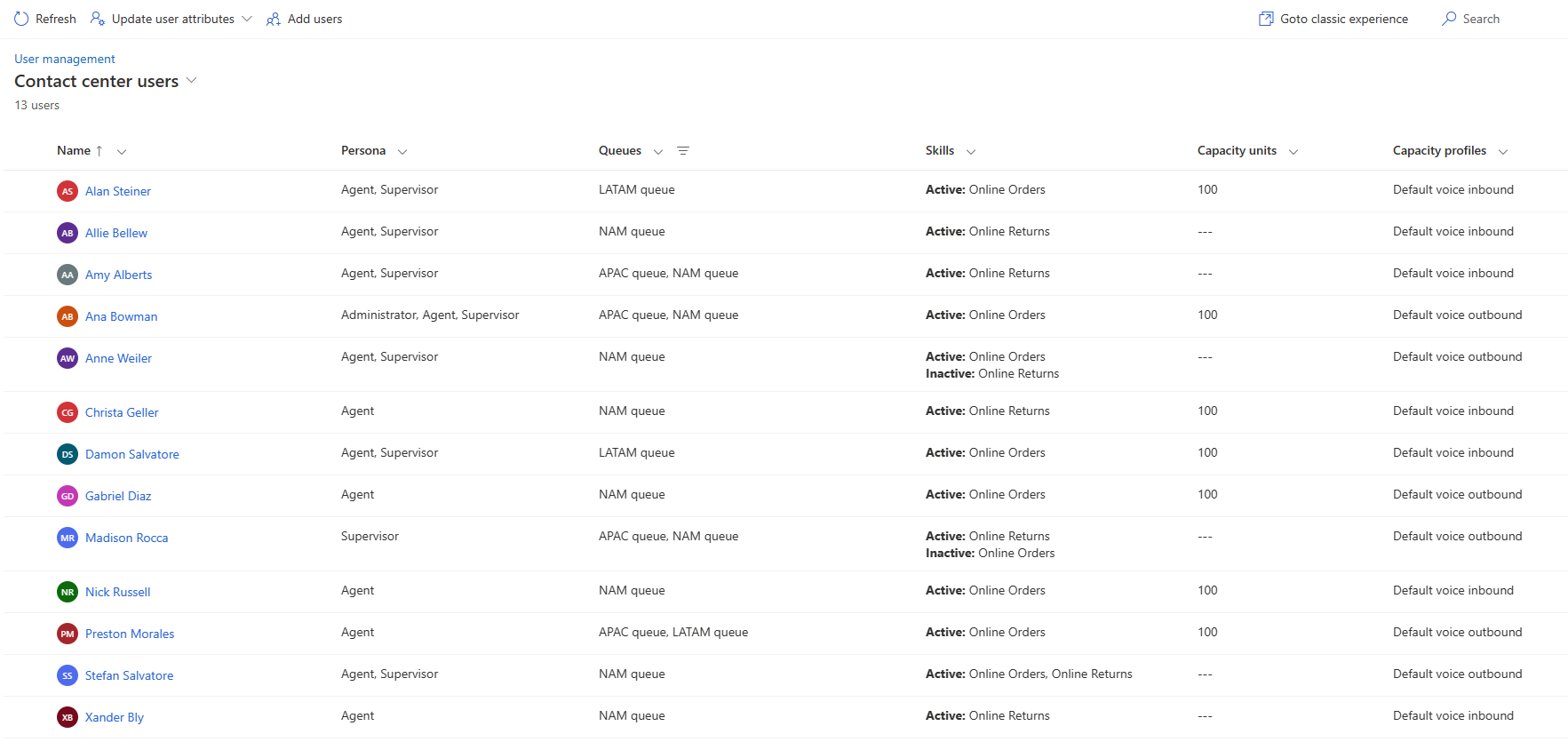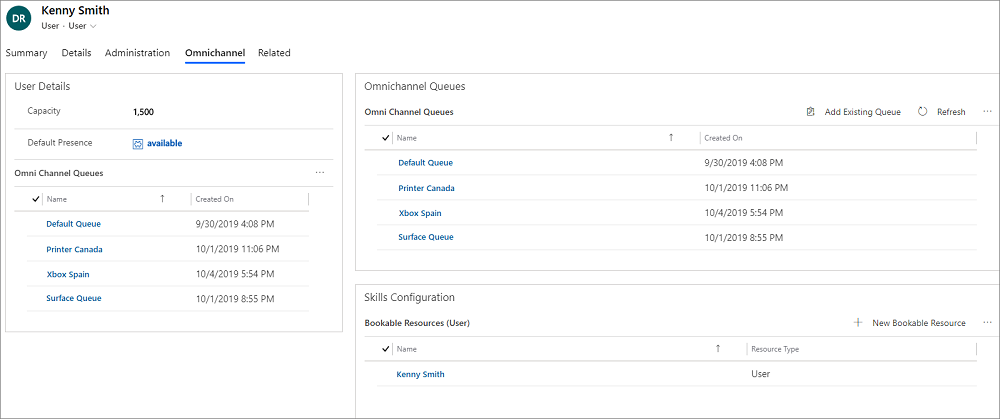Note
Access to this page requires authorization. You can try signing in or changing directories.
Access to this page requires authorization. You can try changing directories.
Applies to: Dynamics 365 Contact Center—embedded, Dynamics 365 Contact Center—standalone, and Dynamics 365 Customer Service
Note
Copilot Studio bot is renamed as Copilot agent (agent or AI agent). Human agent is now renamed as customer service representative (service representative or representative). You might come across references to the old and new terms while we update the product UI, documentation, and training content.
Use the information in this article to manage your service representatives in Customer Service. The enhanced user management experience is a simplified UI that eases the complexity of configuring the various settings required for your representatives to provide customer service optimally.
You can manage the following settings for the users in bulk:
- Skills
- Queues
- Capacity profiles
- Swarming
On the user management page, the following three views are available:
- Contact center users: Lists users who are assigned the representative, supervisor, or admin persona.
- All users: Lists all the Customer Service users.
- Swarm experts: Lists users who are assigned to be swarm experts.
Manage contact center users
The attributes that you want to add must be configured in the system. You can update up to 200 users in a single step. For the selected users, you can update up to five attributes in a single step. If you need to update more than five attributes for the selected users, you can save the changes and then update the next set of attributes.
Sign in to Dynamics 365, and go to the Copilot Service admin center app.
Select User management under Customer support in the site map.
On the page that appears, select Manage for Enhanced user management. The Contact center users view displays the users that have been configured in Power Platform admin center.
Hover the pointer over the rows of the users that you want to update and select the check boxes.
To update user attributes, select Update user attributes, and select one of the following options:
Update skills: On the dialog box that appears, do the following:
- Add skills to users: In the Skills box, select the skills that you want to add, select a proficiency, and then select Add to all. The selected skill and proficiency is added for the users in the list. To have a different proficiency for the skills, select one skill and proficiency at a time.
- Activate or deactivate: Select a skill in the Skills box, and select the ellipses to select Activate for all or Deactivate for all. Users with a deactivated skill will not be considered during assignment if the skill requirement of a work item matches the deactivated skill.
- Remove skills: To remove a skill from the list of users, select the skill in the Skills box, and select Remove from all. Save your changes. The selected skills are removed for the users.
Update queues: On the dialog box that appears, in the Queues box, select the queues to add or remove, and then select Add to all or Remove from all. Save your changes.
Update capacity: On the dialog box that appears, in the Capacity profiles box, select the profiles that you want to add or remove, and then select Add to all or Remove from all. Save your changes.
To add users as swarm experts, select Swarming and then select Add as swarm expert.
If you want to see the list of swarm experts, select the Swarm experts view. More information: Configure customer support swarming
The users and their updated attributes will be displayed in the Contact center users view.

Manage users using the classic experience
Users should be configured as a bookable resource so that they can be assigned work items by using unified routing.
In the site map, select User management in Customer support.
On the User management page, select Manage for Users.
On the Omnichannel Users page, double-click a user in the list.
Select the Omnichannel tab.
Specify the following in the user page.
Section Field Description Example value User Details Capacity If capacity units is configured, allocate a value that indicates the capacity of the representative. Learn more in Capacity. 100 User Details Default Presence Assign a default presence status for a representative. This is the status that the representative is logged in with, in the Omnichannel for Customer Service app. Available Select New Bookable Resource under the Skills Configuration section. The New Bookable Resource page appears.
Do the following:
Specify the name of representative in the Name field.
Select Save. The Work Hours tab is enabled.
Important
To add the work hours for a bookable resource, universal resource scheduling must be available in your organization. Universal resource scheduling is available with Dynamics 365 Field Service, Dynamics 365 Project Service, or Dynamics 365 Service Scheduling. More information: Overview of Service Scheduling
You can update the existing work hours or create work hours for the user.
On the Omnichannel tab of the Bookable Resource page for the user, select New Bookable Resource Characteristic.
In Skill Name, search for and select a skill.
In Rating Value, select the rating value that the user has on the skill.
Save and close to return to the Omnichannel tab of the User page.
If capacity profile is configured, in the Capacity area, select Add Existing Capacity Profile, and select a profile in the list.

To use the user schedule for assignment, set up the bookable resource calendar. Learn more in Apply a calendar to a resource.
Add the user to the required queue that's configured for unified routing. Learn more in Configure queues for unified routing.
Note
Agents in a queue are modeled as a bookable resource and therefore will be considered for assignment. However, we recommend that you don't add agents to queues that are used for routing records.
All users who are assigned the Omnichannel administrator, Omnichannel supervisor, or Omnichannel agent security role can use Omnichannel for Customer Service.
Learn more about how to create users and assign security roles in Assign roles and enable users for Omnichannel for Customer Service.
For users to access the Omnichannel for Customer Service experiences, the roles that you map to personas in role persona mapping must be assigned to the users directly and not through team memberships. Learn more about role persona mapping in Role persona mapping.
Capacity
Capacity is the arbitrary scale that you choose and set for each of the work streams corresponding to the channels. The capacity assigned to the representative must be a multiplier of the capacity unit that you have defined for the associated workstream. Check the capacity unit defined for the workstreams to determine the value that must be assigned to your representatives.
For example, if the capacity unit is 1 for a workstream and you want a representative to be able to take up to 3 conversations simultaneously, the capacity that you assign to the representative should be 3 units. Similarly, if your capacity unit is 5 for the work stream and you want the representative to be able to take up to 3 conversations simultaneously, you should assign 15 units as the capacity. You can also define capacity profiles. However, we recommend that you use either capacity units or capacity profiles in your environment, and not both. Learn more in Create and manage capacity profiles.
Related information
Work with queues in Omnichannel for Customer Service
Configure and manage presence status
Role personas for unified routing
Configure custom limits in capacity profiles